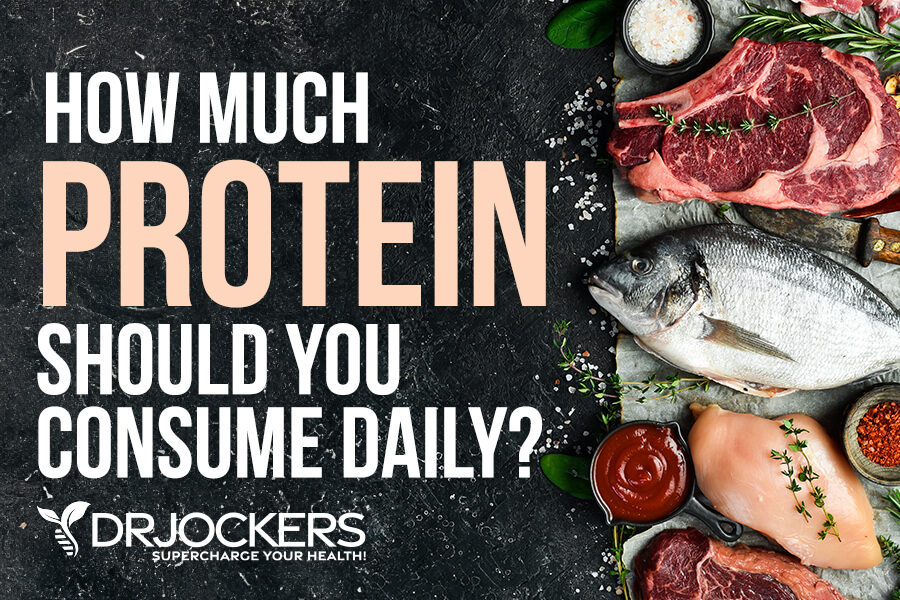 How Much Protein Should You Consume Daily?
How Much Protein Should You Consume Daily?
Protein is the necessary building block of human health. Protein is important for muscle health and muscle recovery, fat burning, improving lean body tissue, stabilizing blood sugar levels, reducing cravings, supporting satiety, and many other areas of your health.
We all need to eat protein and most foods contain some level of protein. How much protein you eat and what sources your protein comes from all matters. This is what we will talk about in this article: how much protein should you consume daily, and what are the best sources of protein?
In this article, you will learn what protein is. I will discuss the benefits of protein and the best food sources. You will understand the difference between complete and incomplete protein. You will learn about the importance of amino acids.
I will discuss the importance of leucine threshold for muscle protein synthesis. I will talk about the connection between protein and the mTOR pathways. I will discuss the importance of time-restricted feeding. You will learn about protein cycling. Finally, I will share my favorite helpful protein supplements.
What is Protein?
Along with fats and carbohydrates, proteins are essential micronutrients. Macronutrients are nutrients your body needs in large quantities for energy, function, and health. Micronutrients, such as vitamins and minerals, are nutrients your body needs in smaller quantities.
Proteins are large, complex molecules that are found throughout your body in your bones, muscles, hair, skin, and essentially in all parts of your body. They play a critical role in the structure, function, and regulation of your tissues and organs.
There are over 10,000 different types of proteins depending on their makeup, structure, and function. Proteins are made up of amino acids, which are smaller units that serve as building blocks. Since your body cannot store amino acids, your body either needs to make them from scratch or by modifying other amino acids.
But your body cannot make every amino acid. Histidine, isoleucine, leucine, lysine, methionine, phenylalanine, threonine, tryptophan, and valine are the nine essential amino acids that your body must get from food. Thus, it’s critical for us to talk about what kind of proteins you need to eat and how much to meet your body’s protein and amino acid needs.

Benefits of Protein
Protein has many roles and benefits in your body. Protein can help to burn fat, improve lean body tissues, support muscle recovery, improve satiety, stabilize blood sugar levels, reduce cravings, and make intermittent fasting easier. Let’s talk about the benefits of protein in more detail.
Blood Sugar Stability
The more stable your blood sugar is, the better your energy, cognition, and ability to think sharply will be. While food can affect your blood sugar levels, you don’t want quick blood sugar highs followed by quick drops. Foods high in protein are naturally lower glycemic index foods, which means that they are less likely to cause blood sugar fluctuations.
A 2003 study published in the American Journal of Clinical Nutrition has found that an increasing protein intake may support blood sugar balance in people with type 2 diabetes (1). A 2021 study published in the Iranian Journal of Public Health has found that focusing on protein is important for glycemic control (2). Combining protein with carbs is better for blood sugar balance than carbs alone.
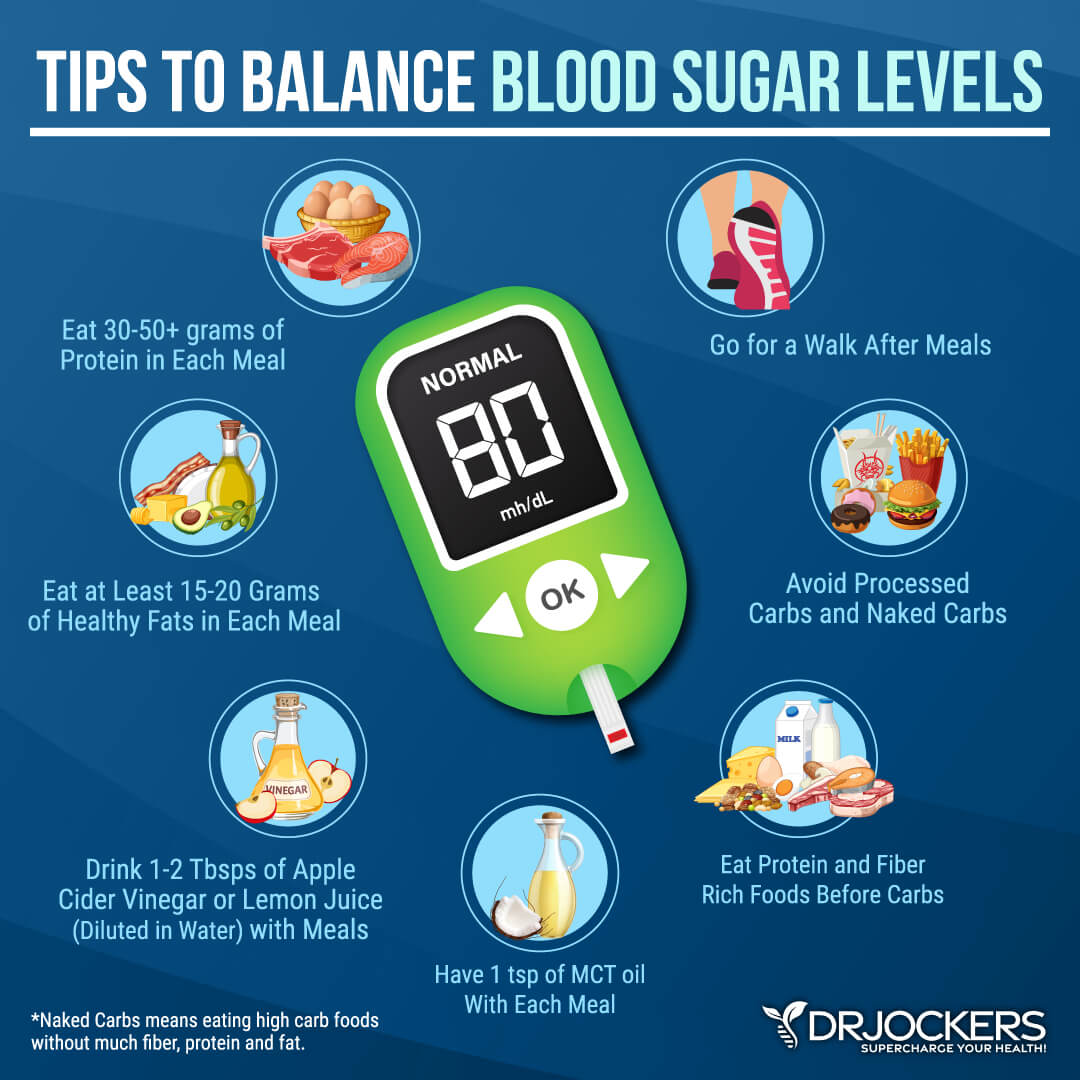
Reduces Cravings
Protein can reduce cravings, so you will be less likely to reach for unhealthy or sugary foods. Thus, it also reduces the risk of weight gain, obesity, inflammation, and chronic disease. Protein supports satiety and healthy blood sugar levels, which can both help to reduce cravings.
A 2011 study published in Obesity (Silver Spring) has found that higher protein meals may reduce cravings by 60 percent and support weight loss (3). According to a 2014 study published in the Nutrition Journal, high-protein breakfast may affect the levels of plasma homovanillic acid (HVA), which is an index of central dopamine production, and it may reduce cravings and support weight loss as a result (4).
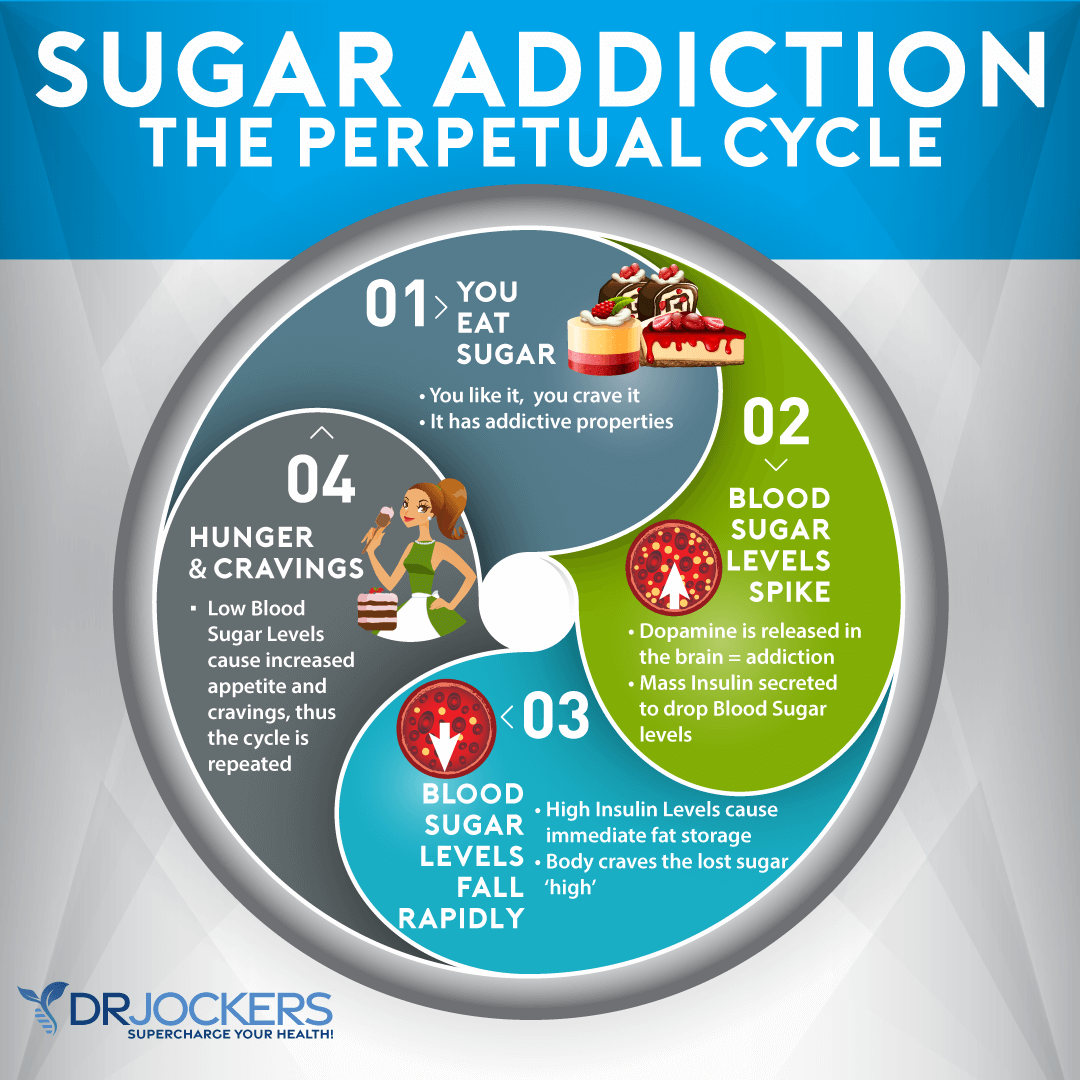
Improves Lean Body Tissue
Protein also helps to maintain body mass and improve lean body tissues. Especially as people age, people can develop muscle loss or sarcopenia. The more muscle you lose as you age, the higher your risk of chronic disease and mortality. Maintaining lean body mass is critical.
A 2015 systematic review published in Sports Medicine has found that protein is important for supporting muscle mass, anaerobic power, and strength (5).
A 2021 systematic review and meta-analysis published in Nutrition Reviews has found that increasing protein in the diet by .1g/kg per day (up to 3.5 g/kg per day) for a few months may help to increase or maintain lean body mass (6). I suggest a minimum of 1 gram per kg of body weight per day to maintain muscle mass and more protein than this for overall health.
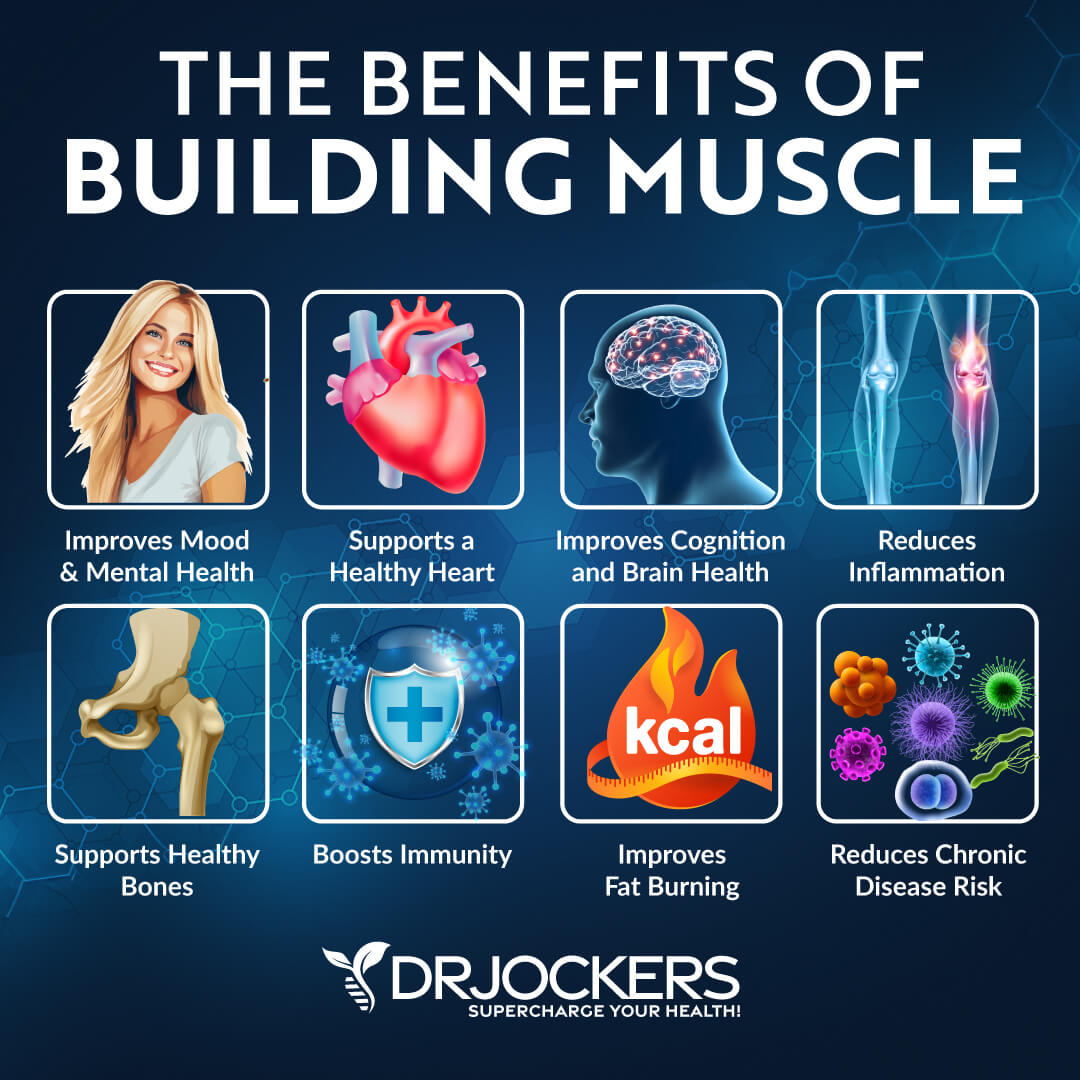
Helps Burn Fat
Protein also helps to burn fat and become a fat burning machine. This can support your exercise, fitness, and weight loss goals. According to a 2002 study published in the Journal of American College of Nutrition, eating plenty of protein may stimulate thermogenesis, which is the regulation of body temperature (7).
Increasing thermogenesis may improve fat burning. A 2012 study published in Nutrition Metabolism (London) has found that protein may help to reduce body fat, improve body composition, and improve weight loss (8).

Improves Satiety
Protein may improve satiety which may help to reduce cravings and aid weight loss or weight maintenance. A 2020 study published in the Journal of Obesity and Metabolic Syndrome has found that a high-protein plan may support thermogenesis, decrease orexigenic hormones, lower anorexigenic hormone levels, improve satiety signaling, reduce cravings, lower food intake, and support weight loss (9).
2023 research published in the Journal of Dairy Science has found that consuming a high-protein breakfast may help to improve both satiety and cognitive concentration (10).

Supports Muscle Recovery
Protein may also support muscle repair and muscle recovery, thus supporting your exercise routine. A 2018 study published in Frontiers in Nutrition has found that supplementing with protein long-term may help to improve recovery and support performance in endurance sports (11).
A 2023 systematic review and meta-analysis published in the European Journal of Clinical Nutrition has found that peri-exercise protein use may help to reduce creatine kinase concentration, maintain strength, and support recovery (12).
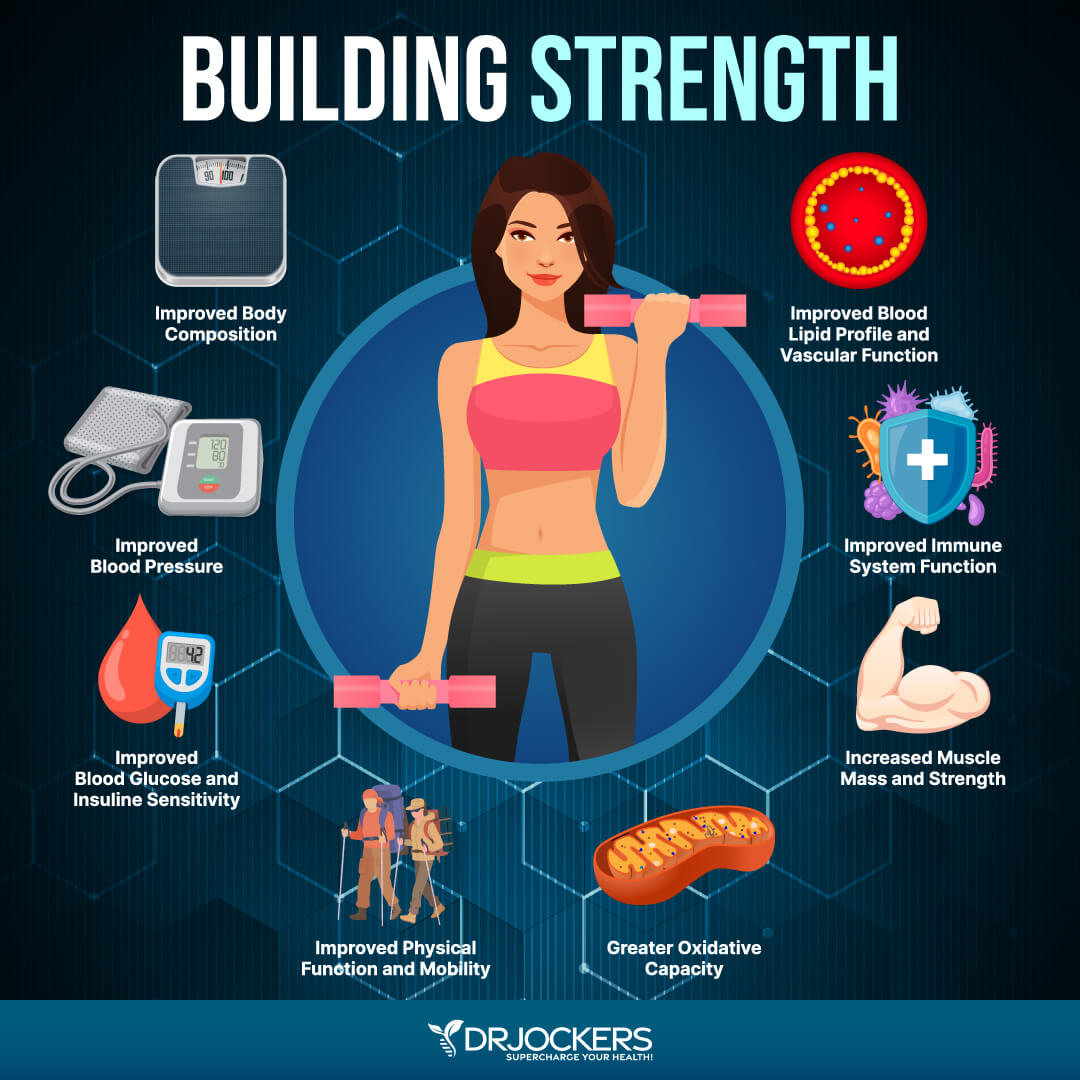
Makes Intermittent Fasting Easier
Intermittent fasting is a dietary strategy when you are cycling between a period of fasting (not eating) and eating during the day. The most popular form of intermittent fasting is the 16:8 fasting that involves 16 hours of fasting with an 8-hour eating window reserved for meals in one day. Intermittent fasting is a fantastic strategy to improve blood sugar levels, reduce obesity, improve tissue health, reduce inflammation, boost cognition, and so on.
Since protein can help to keep your blood sugar levels stable, improve satiety, and reduce cravings, it can help you stick to your eating window and successfully fast during your fasting window without feeling tired or hungry.
A 2022 study published in Obesity (Silver Spring) has found that the combination of intermittent fasting and protein pacing may be better for losing visceral fat and weight than restricting calories (13). It may be effective for hunger management, weight loss, and fat loss, and improving body composition, and cardiometabolic health.

Best Protein Foods
So, what are the best protein foods? Animal protein sources offer the most complete amino acid profiles and the best digestive bioavailability. However, in addition to animal protein, there are some plant-based sources of protein, such as organic plant protein powder, nuts, seeds, beans, lentils, and other legumes, that may be beneficial.
Nuts, seeds, and legumes, however, are less bioavailable than animal protein sources and can be hard to digest and absorb for some. I recommend nuts, seeds, and legumes along with animal protein instead of relying on them by themselves.
The best protein foods may include:
- Grass-fed meat
- Wild-caught fish and seafood
- Pasture-raised poultry and eggs
- Organic Greek yogurt
- Organic cheeses
- Grass-fed whey or egg or beef protein powder
- Organic plant protein powders, such as pea protein
- Nuts and seeds
- Beans, lentils, and fermented soy (tempeh)
Complete Proteins
As I mentioned earlier, there are 20 amino acids your body needs to function well. Nine of these amino acids are essential amino acids. Complete proteins include all these nice essential amino acids.
Complete protein sources include:
- Grass-fed meat
- Wild-caught fish and seafood
- Pasture-raised poultry and eggs.
- Organic Greek yogurt
- Dairy products, including organic cheeses.
- Grass-fed whey or egg or beef protein powder
- Whole sources of soy, such as tempeh, miso, tofu, and edamame
- Organic plant protein powders, such as pea protein

Incomplete Protein Sources
Incomplete proteins don’t include all nice essential amino acids. This doesn’t mean that they are not good protein sources. It means that they are not enough alone to meet your protein and amino acid needs.
As you may notice, most complete protein sources are complete proteins, and incomplete protein sources are plant-based. Thus, it can be more difficult to meet your protein and all amino acid needs on a vegan or vegetarian diet.
Incomplete protein sources include:
- Nuts and seeds.
- Legumes, including beans and lentils.
- Whole grains
- Some vegetables
Most Nutrient-Dense Protein Sources
I recommend that you are focusing on high-quality, nutrient-dense protein sources with complete protein. The most nutrient-dense protein sources include grass-fed animal products, wild-caught fish and seafood, and pasture-raised poultry and eggs. These are the best options.
Plant sources of protein are not as good as they are incomplete protein sources. They may be less bioavailable and some plant-based protein sources, including beans, may be hard on your digestion. However, you can still use plant sources of protein, but it’s better not to rely on them completely.
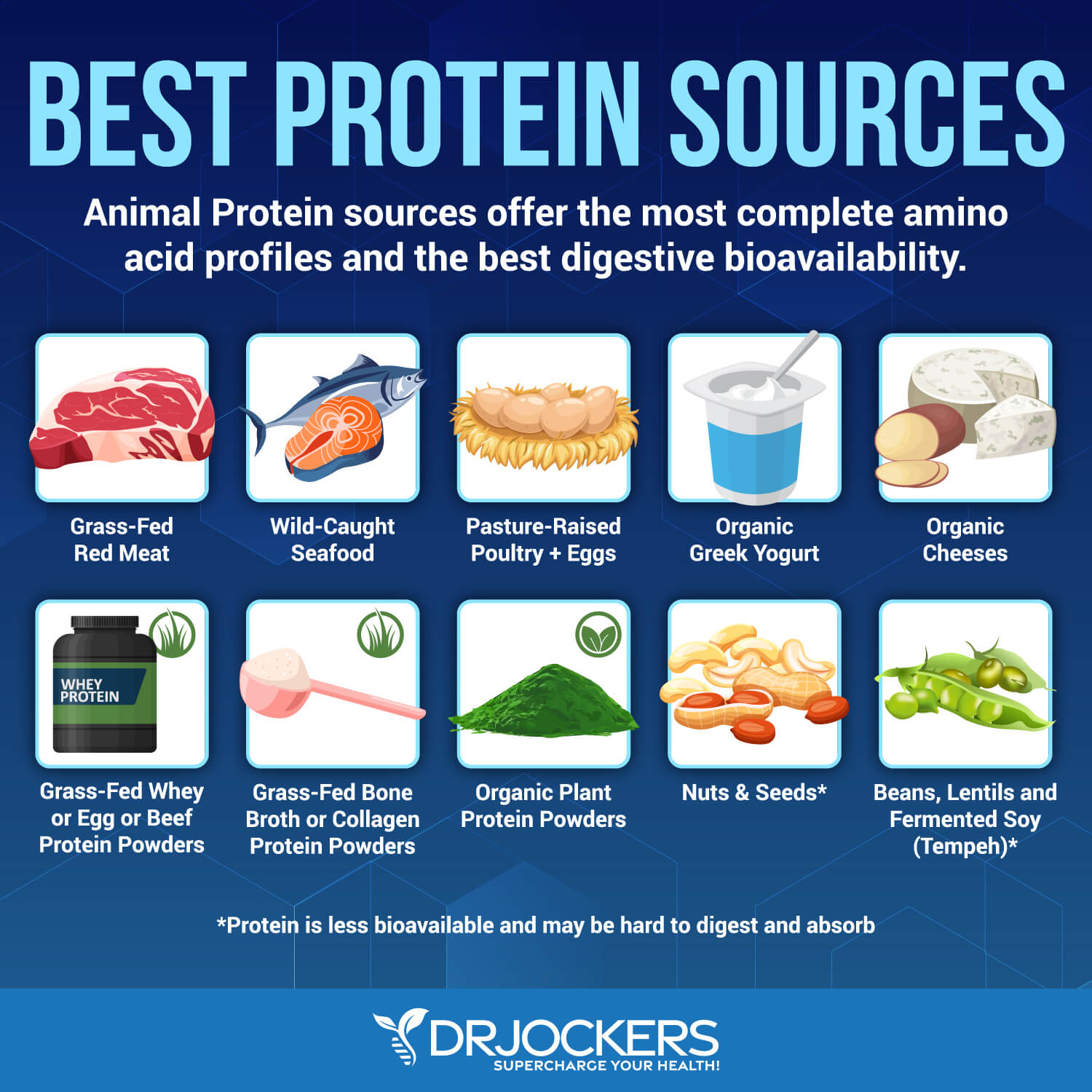
Importance of Amino Acids
I’ve already mentioned amino acids earlier. They are molecules that make up amino acids. Proteins are essentially long-chained amino acids, with each protein having is unique amino acid sequence. Due to this unique sequence, each protein has its unique shape and function.
Your body needs about 20 amino acids to function. While your body can make some of these amino acids, it cannot make all.
Essential amino acids are amino acids your body is unable to make, and you need to get them from food. The nine amino acids you need to get from food include histidine, isoleucine, leucine, lysine, methionine, phenylalanine, threonine, tryptophan, and valine (14).
- Histidine is a neurotransmitter that makes histamine. It’s critical for immune health, sleep, gut health, and sexual function.
- Isoleucine is necessary for immune function, muscle metabolism, and energy.
- Leucine is necessary for your body to make protein and growth hormone and its needed for wound healing, muscle repair, muscle growth, and stable blood sugar.
- Lysine is necessary for hormonal health, energy, and immune function.
- Methionine is needed for detoxification, metabolism, and tissue growth.
- Phenylalanine is necessary for making chemical messengers in the brain, such as epinephrine, norepinephrine, and dopamine.
- Threonine is essential for collagen and elastin, connective tissue health, skin health, immune function, and fat metabolism.
- Tryptophan is essential for nitrogen balance and making serotonin for sleep, appetite, and mood regulation.
- Valine is essential for muscle growth, muscle and tissue repair, and energy.
Branched-chain amino acids (BCAAs) are also amino acids that you have to get through diet as your body cannot make them. Unlike other amino acids, your liver doesn’t have enzymes to catabolize them. BCAAs include leucine, isoleucine, and valine (15). BCAAs are actually the amino acids people use to support their workouts and recovery.
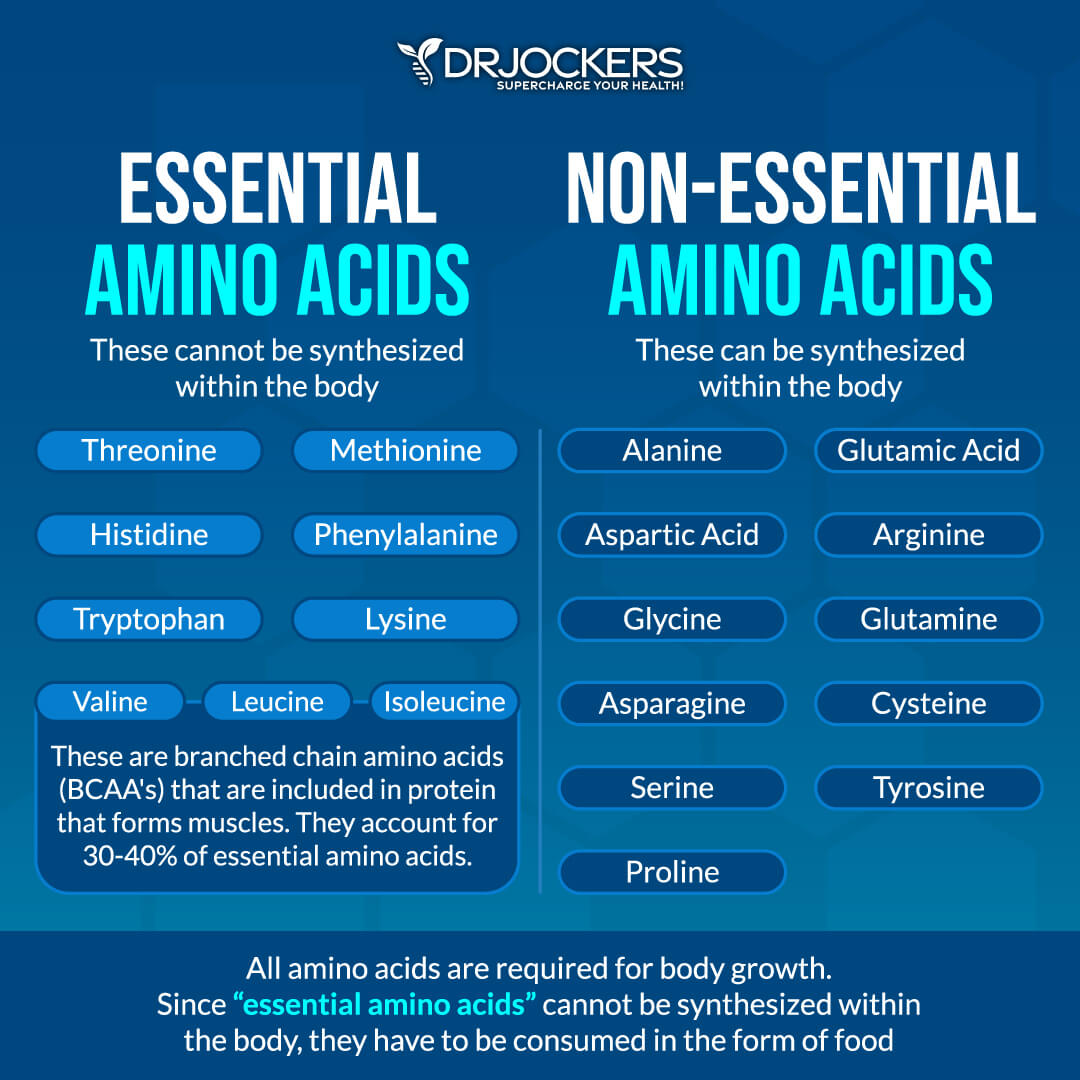
Leucine Threshold for Muscle Protein Synthesis
So, BCAAs are great for supporting workouts and muscle recovery. If you want to optimize the effects of your workouts, this is what you need. Leucine is the main BCAA. Its main role is to support muscle building. Just like other amino acids, it is a building block of muscles. But it also acts as an anabolic trigger. This means that it serves as a signal triggering your body to build more muscle protein.
According to a 2006 study published in the Journal of Physiology, leucine may help to improve muscle protein synthesis and reduce muscle loss in elderly male subjects (16). This means that leucine is beneficial even for older individuals, not just younger people who are working out a lot and want to build a muscular physique. According to a 2016 study published in the European Journal of Clinical Nutrition, leucine may help to increase muscle mass, improve body composition, and support performance (17).

How to Get Your Leucine Threshold
So, using leucine is particularly important for building muscle. However, how much leucine you take in matters. You need to hit somewhere between 2 to 3 grams per meal to meet your needs.
Most proteins are about 10 percent leucine, so I typically recommend 30+ grams of protein per meal for those 150 lbs or more. Those under 125 lbs can do 25 grams, and those under 100 lbs can do well on 20 grams.
It is important that you rely on high-leucine protein sources for the most part, especially if muscle health and muscle gain are your goals. According to a 2021 study published in Frontiers in Nutrition and the database of the United States Department of Agriculture (USDA), beef, lamb, deer, chicken, turkey, rabbit, bovine, and fish are among high-protein foods rich in leucine (18, 19). Most dairy and plant sources of protein are also good sources of leucine.
While collagen and bone broth protein are great protein sources, however, they are very low in leucine at around 4.6 percent. They are rich in glycine, proline, and hydroxyproline and are great for healthy gut lining, joints, bones, and skin. But for muscle protein synthesis, it’s not enough.
For muscle growth and muscle health, you need to focus on high-leucine foods. This doesn’t mean you shouldn’t use collagen or bone broth protein. They have fantastic benefits. However, you need to add high-leucine foods and adjust your protein intake accordingly to hit your leucine threshold.
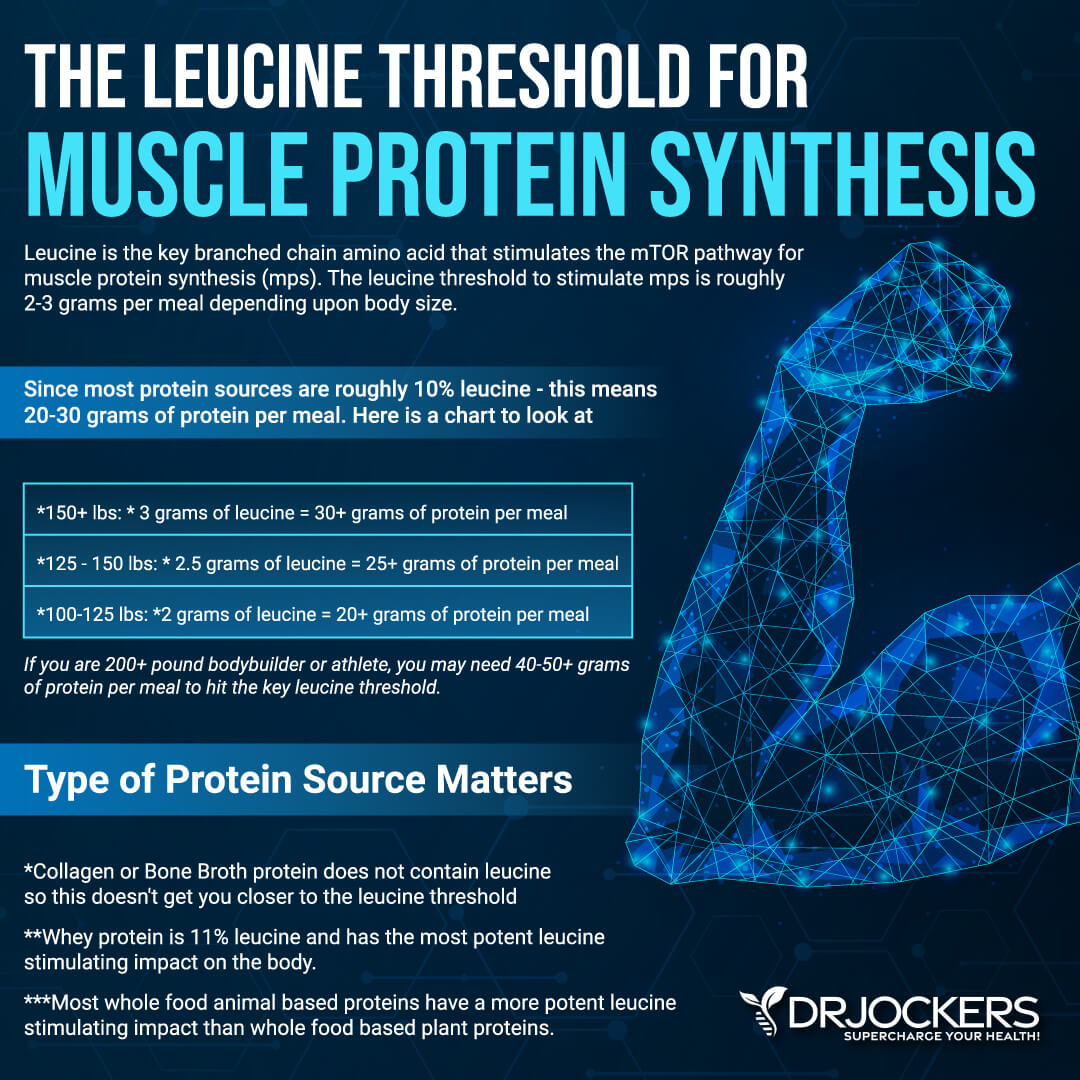
Protein and mTOR Pathway
Protein intake stimulates a physiological pathway in the body called mTOR. The mammalian target of rapamycin (mTOR) is also known as the mechanistic target of rapamycin or FK506-binding protein 12-rapamycin-associated protein 1 (FRAP1). It connects with other proteins and is an important part of two protein complexes that regulate cellular processes, including the mTOR complex 1 and mTOR complex 2.
The mTOR pathway is linked to the regulation of growing tissue in the body. It helps to regulate cellular survival, cellular growth, cell motility, cell proliferation, autophagy, and protein synthesis. Temporary increase in mTOR is important for building muscle mass and fat burning.
While temporary elevations in mTOR are great for building muscle and burning fat, chronically elevated mTOR is associated with increased cancer risk and chronic disease. This is because one of the responses from mTOR is that it blocks autophagy which can lead to abnormal cell growth (20, 21, 22). Thus, chronically elevated mTOR may increase the risk of chronic disease and cancer.
A high protein diet, a high carb diet, branched chain amino acid, high insulin levels, high testosterone, exercise, strength training, and inflammatory cytokines can all activate mTOR. This is beneficial in the short-term. Since mTOR can be a problem when turned on chronically, you can use mTOR inhibitors to create health and balance.
mTOR inhibitors include fasting, ketosis, resveratrol quercetin, curcumin, caffeine, berberine, and EGCG. You may learn more about this in this article.
Since increased insulin and carbs can turn on mTOR, which explains why young people can often build muscle even if their protein intake is low. However, as you age, mTOR may become primarily sensitive to leucine, making it more crucial to meet your leucine threshold.
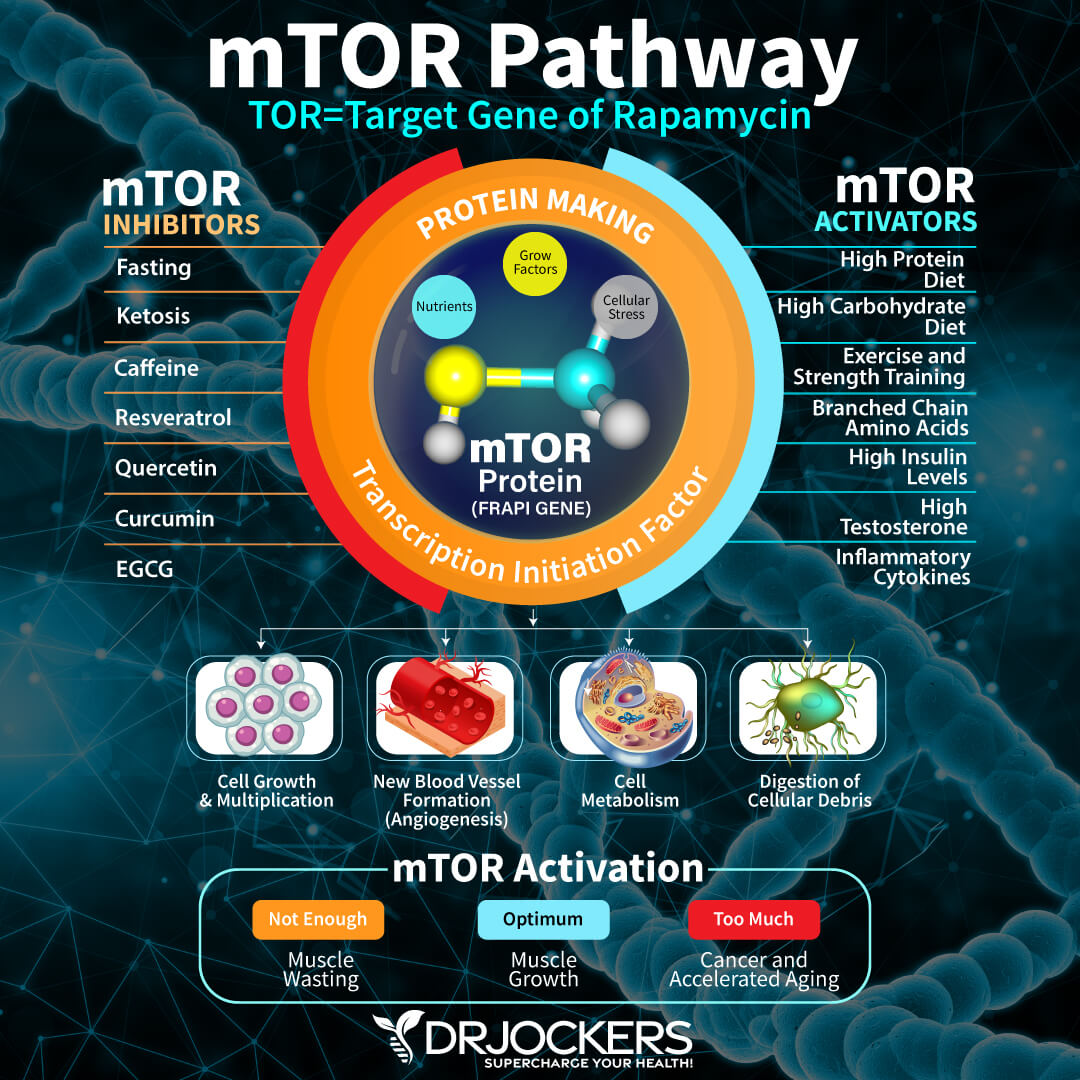
Importance of Time-Restricted Feeding
Time-restricted feeding is very important. Eating protein is good for you, but eating too much protein without a time-restricted feeding window can be an issue. If you eat every 2 to 3 hours, high-protein meals every time, all day long when you are awake, it can increase inflammation. Sure, if you are a bodybuilder, it can help with muscle building but it can also increase inflammation and cellular damage.
Instead, I recommend a time-restricted feeding schedule with an 8-hour eating window and a 16-hour fasting window. Time-restricted feeding can help to inhibit mTOR and turns on autophagy to clean up and refresh damaged proteins and damaged mitochondria. Time restricted feeding may help with mitochondrial health, eliminating viral infected particles, reduce cellular apoptosis, improve insulin sensitivity, and create a stronger body.
According to a 2021 study published in Vurusdisease, time-restricted feeding may help to inhibit the mTOR pathway, support autophagy, reduce inflammation, and, as a result, may reduce the severity of viral diseases (22).
According to a 2021 review published in Cell Death & Disease, time-restricted feeding may inhibit the mTOR pathway and improve mitochondrial oxygen utilization efficiency to support ATP production under acute hypoxia, which is a state when not enough oxygen is available to the body (23).
Targeted regulation of the mTOR pathways through time-restricted feeding may help to improve acute hypoxic tolerance. You can learn more about time-restricted feeding by reading this article.
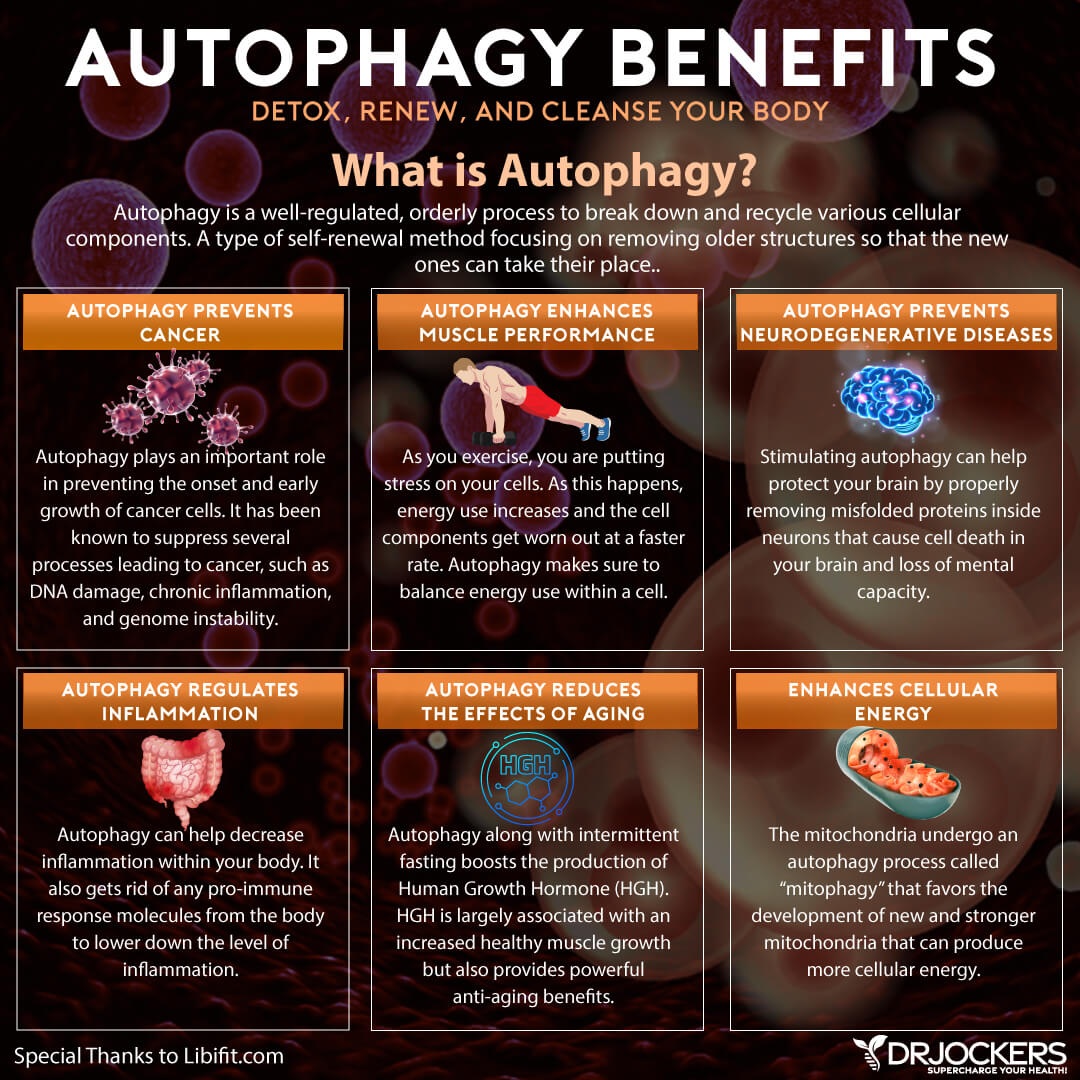
Protein Cycling
Along with time-restricted feeding, protein cycling can also help your goals. Protein cycling means that you are alternating between periods of normal to high protein consumption to periods of low protein consumption. Time-restricted feeding helps with this.
During your fasting period, you are not eating anything, thus you are not consuming any protein for 16 to 18 hours or even longer. Moreover, during your eating window, you shouldn’t be grazing and eating constantly.
Eat only 2 to 3 meals with no snacking, this way, you still have several hours of not consuming protein, giving yourself some space. If you are only practicing intermittent fasting a few times a week, you can also reduce your overall protein consumption on those days compared to other days. A one-day fast is also a great option to reduce protein consumption.
I recommend consuming 30 to 50+ grams of protein per meal. However, I only recommend eating 2 to 3 meals per day with no snacking. I recommend following time restricted feeding and consuming your protein and meals within a 6 to 8-hour eating window and doing a 16 to 18-hour fast at least 2 to 3 times per week. I also recommend a 20 to 24-hour fast once a week.
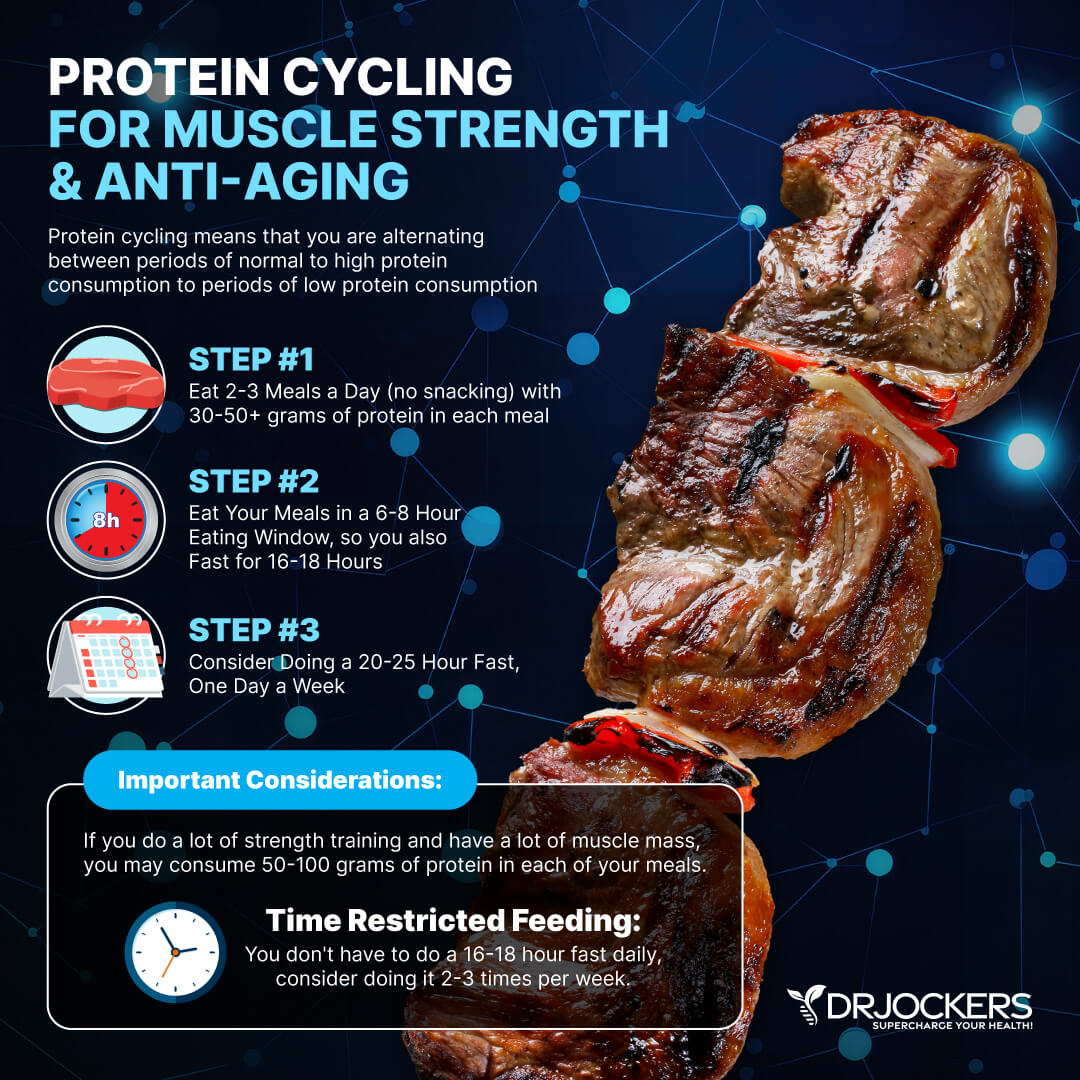
Using Protein for Your Goals
People often ask me how much protein they should consume in a given day. My answer is always, “It depends”. That is because your daily requirements can vary greatly depending on your lifestyle and health goals.
Here I am going to outline how you can determine your personal sweet spot depending on what you are trying to achieve. The most important thing is to remember that there is no real downside to consuming a high protein diet, but there are major problems that can occur if you do not consume enough protein in your diet.
Each of the guidelines detailed below is based off of your weight in kilograms. To get this number, simply take your weight in Lbs. and divide it by 2.2. For example, a 160 Lb. individual is about 72 kilograms.
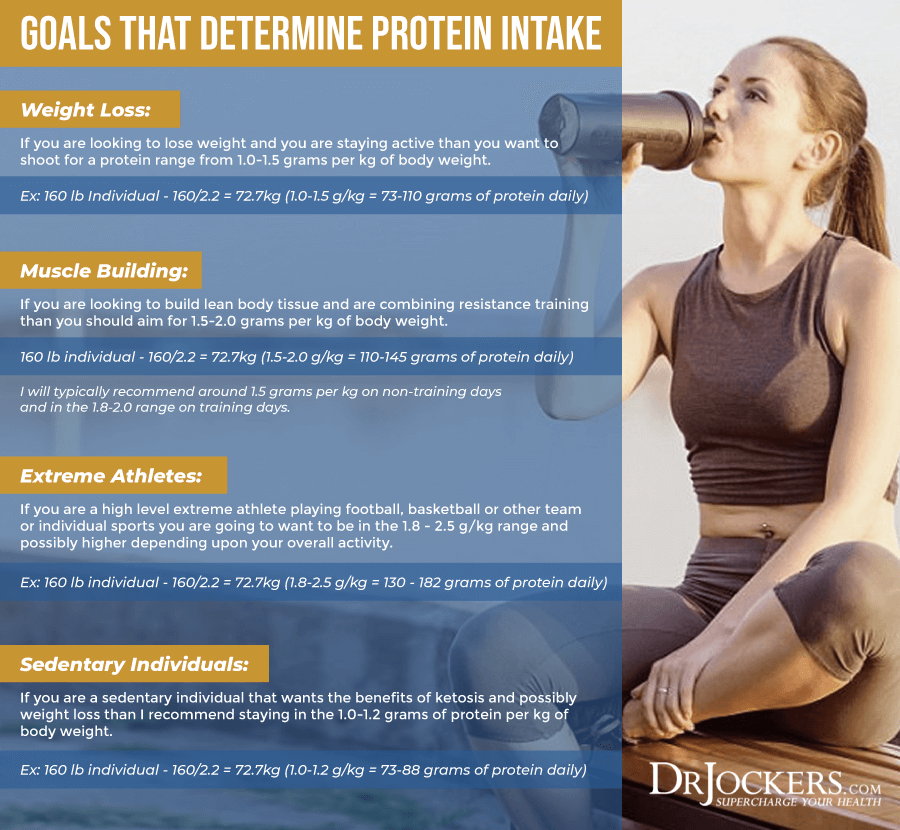
Weight Loss (combined w/exercise)
Eating the right amount of protein for weight loss, given that you are also an active person, is important. Too much could prevent weight loss while too little might not be ideal for retaining lean muscle mass.
If your goal is to lose weight while maintaining an active lifestyle, then you would want to shoot for 1.0-1.5 grams of protein per kg of bodyweight. This is roughly 50-70% of your body weight in pounds in grams of protein per day.
Muscle Building
If you are engaging in strenuous exercise that leads to increase muscle hypertrophy, then you will need a higher daily protein intake. Those engaging in bodybuilding, frequent weightlifting, (4-6 days per week) and high-level athletics will typically fit in this category.
If your goal is to build muscle during an intense workout regimen, then 1.5-2.0 grams of protein per kg of bodyweight is a great target. Reserve the higher end of that range for hard training days. This is roughly about 80-90% of grams per protein as your body weight in pounds.
Extreme Athletes
If you find yourself grinding for 2-3 hours a day, 5-7 days a week, you will absolutely need to up your protein intake a bit higher. Additionally, it may be advantageous to utilize an essential amino acid complex (such as this one) to provide an easy-to-use source of muscle-repairing amino acids.
If you are challenged daily to the point of exhaustion and need to constantly push the boundaries of your fitness, 1.8-2.5 grams of protein per kg of bodyweight is where you should aim to be.
Sedentary Individual
Many people do not exercise on a regular basis. This could be due to choice, or due to time restraints and work habits. Either way, these individuals will need much less protein than most people as they do not incur as much muscular damage.
If you are mostly sedentary and do not partake in any form of strenuous exercise, you will likely do just fine in the range of 0.8-1.0 grams of protein per kg of bodyweight.
Chronic Disease
Those with chronic diseases such as diabetes, arthritis, or metabolic syndrome will receive tremendous benefit from following a ketogenic style diet. This is where you train your body to burn fat as energy instead of sugar (learn more here).
Lower amounts of protein are needed on a ketogenic diet because this style of eating actually provides a muscle sparing effect. Additionally, too much protein can prevent someone from entering this fat-burning state.
If you are enduring some type of chronic disease, a ketogenic diet with 0.8-1.0 grams of protein per kg of bodyweight can be powerful.
Metastatic Cancer
Speaking of chronic disease, cancer is something that emerges due to chronically dysfunctional mitochondria that are stuck in sugar-burning metabolism. Cancer cells, unlike healthy cells, do not have the ability to burn ketones (fats) for energy.
Additionally, there is a growing body of evidence suggesting that the mTOR pathway in the body is closely linked with cancer growth. The mTOR pathway can be stimulated by a number of different things. The intermittent stimulus of this pathway is important for the body, however chronic stimulation may aggravate cancer growth.
Following a ketogenic diet and reducing protein intake to 0.5-0.8 grams per kg of bodyweight is an important consideration to make if you are fighting cancer.
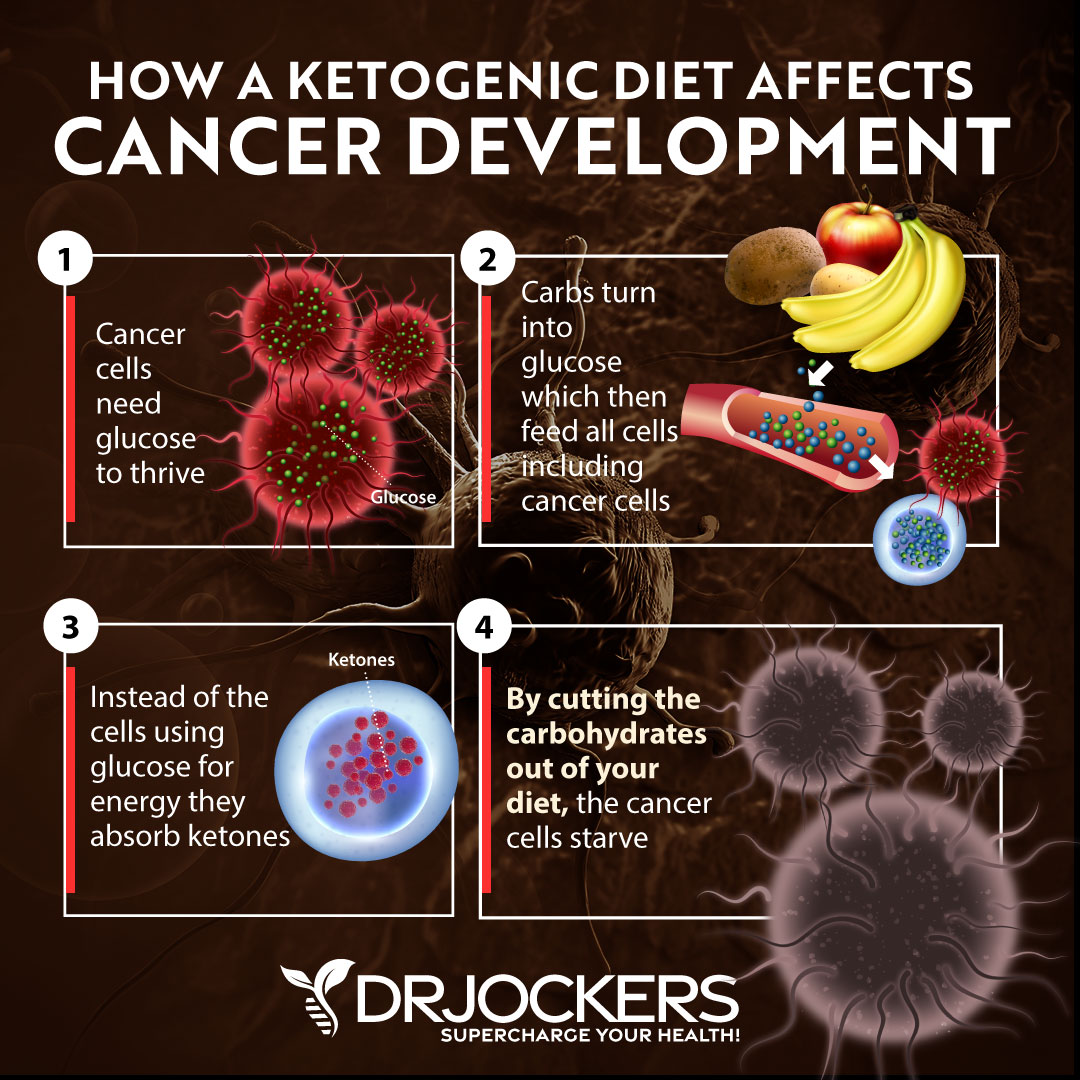
Helpful Protein Supplements
You can improve your protein levels and supplement high-quality protein foods with protein supplements. Here are the top supplements I recommend:
Whey Strong
I recommend Whey Strong. Whey strong is made with proprietary native whey protein concentrate from grass-fed dairy cows. It’s produced using a proprietary filtration process and drying using minimal processing.
It has 20 grams of protein per serving, and it’s a great source of leucine. It also contains iron, potassium, calcium, and sodium. Whey protein also contains 10 percent leucine.
Gut Healing Protein
I recommend Gut Healing Protein. This supplement is designed to support gastrointestinal function and balanced detoxification. This is a vegan protein blend with pea and rice protein and all the amino acids you need.
It also contains glutamic acid, quercetin, preventium, aminogen, and stabilized flaxseed for gastrointestinal health, rutin, ginger, curcumin, and niacnamide for cytokine balance, and pomegranate extract, sodium sulfate, and NAC for hepatic health and detoxification. It is also full of vitamins and minerals for overall health and wellness. One serving contains 26 grams of protein and 2.49 grams, along with other essential amino acids.
Amino Strong
Finally, I recommend Amino Strong. This supplement represents a breakthrough in the use of amino acids for muscle protein synthesis. It helps with supporting muscle strength, improving muscle function, and reducing muscle loss due to aging or inactivity.
It provides the right ratio of amino acids to help you reach your goals. It contains 1.5 grams of leucine along with other important amino acids.
Final Thoughts
Protein is the necessary building block of human health. It is critically important for muscle health and muscle recovery, fat burning, improving lean body tissue, stabilizing blood sugar levels, reducing cravings, supporting satiety, and many other areas of your health.
Getting enough protein from the right food sources is critical for your health. I recommend that you follow my tips in this article on how much protein to eat, what protein sources to use, and what helpful supplements to try for better health.
If you want to work with a functional health coach, I recommend this article with tips on how to find a great coach. On our website, we offer long-distance functional health coaching programs. For further support with your health goals, just reach out—our fantastic coaches are here to support your journey.
Inflammation Crushing Ebundle
The Inflammation Crushing Ebundle is designed to help you improve your brain, liver, immune system and discover the healing strategies, foods and recipes to burn fat, reduce inflammation and Thrive in Life!
As a doctor of natural medicine, I have spent the past 20 years studying the best healing strategies and worked with hundreds of coaching clients, helping them overcome chronic health conditions and optimize their overall health.
In our Inflammation Crushing Ebundle, I have put together my very best strategies to reduce inflammation and optimize your healing potential. Take a look at what you will get inside these valuable guides below!



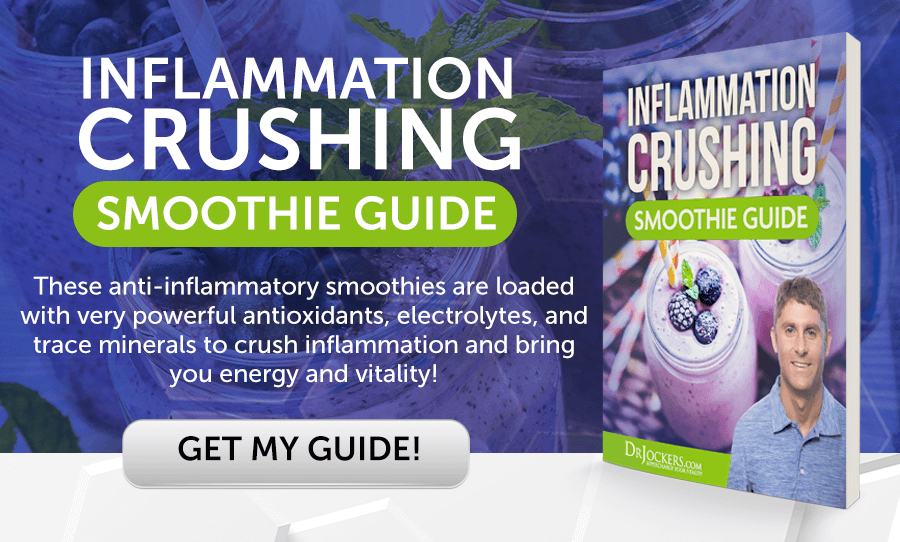


I’m on a low sulfur diet. I’m wondering if the sulfur in eggs is in the yolks or whites? Or both pretty equally? I have eliminated eggs as much as possible and I sure do miss them.
Thank you Dr Jockers for all you do for so many. May God continue to bless you!
Hey Nan, the sulfur is in both the white and yolk but more so in the white. If you are going to add one back, I would try the yolk and see how you do.
Regarding daily protein:
Is this right? I’m a 68 yr old woman 134 lb= about 60 grams of protein per day?
With 3/4 cup of chicken= 95 grams, I’d be eating less than 3/4 cup of chicken
once a day?
So would be the right about of protein per day?
Yes that is correct Zoe, a little bit over that should be okay. It is just a ballpark number!
Can anyone suggest a good web site or book that can help me know the protein content of nuts, seeds, grains, vegetables and fruits. The protein content of animal proteins are easier to find. I don’t eat any prepared foods.
Cronometer.com is a good nutrient tracking web based app.
I have a question about the keto regimen and cancer. Respectfully, where are the survivors? I would love to see verified cases – even anecdotal – of ones who have healed cancer with ketogenic methods. Plant based whole food diets have such results. The science for keto is compelling, but where are the results?
The Truth About Cancer Series is a great place to start! I work with many individuals myself as well Terry!
Thanks, Dr. Jockers. How much protein do you recommend for a 62-year old male who is trying to gain muscle and who regularly lifts weights? Thanks!